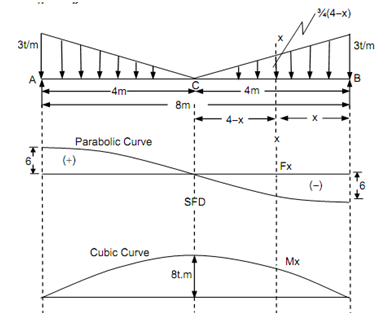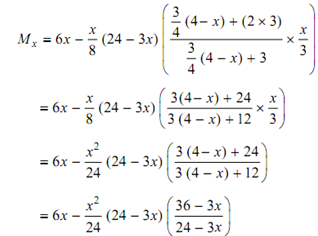Simply supported beam - Shear Force diagram:
A simply supported beam of length 8 m is subjected to a consistently varying load from zero at centre to 3 t/m at both of ends. Draw the BMD and SFD.
Solution
Taking moment around A,
R B × 8 - (½) × 4 × 3 (4 × (2/3) × 4 ) - 1 × 4 × 3( (1/3) × 4 ) = 0
RB = 6 t
R = ( (½) × 4 × 3) × 2 - R B = 12 - 6 = 60
On the other hand, since the load is symmetrical, the reaction at the support shall be equal to half of the entire downward load.
RA = RB = 6 t

Figure
Shear Force
SF at A, FA = +6t
SF at C, FA =+ 6 - (½) × 4 × 3 = 0
SF at B, FB = 0 - (1 /2)× 4 × 3 = - 6 t = Reaction at B.
To determine the form of SFD, let a section XX at a distance 'x' from the end B.
F x =- 6 + (½) × x × ( 3 + (3 /4)(4 - x) )
=- 6 + (½) × x × (12 + 3 (4 - x) /4)
F x =- 6 +(x/8) × (12 + 12 - 3x) =- (48 + 24 x - 3x2 )/8
As, the SF equation is parabolic equation, the SFD is in the form of parabolic curve.
Bending Moment
BM at A and B, MA = MB = 0
BM at C, M C = (6 × 4) - ( (½) × 4 × 3 × (2/3) × 4 )= 24 - 16 = 8 t m
Maximum bending moment take place at centre, as, the SF is zero at centre of the beam.
Bending moment at XX,

= 6x-( x2/24)(36-3x)
= 6x- (3x2/24)-(3x3/24)
Mx = 6x - (3x2/2)-(x3/8)
This equation denoted that the bending moment diagram is in the form of cubic curve.